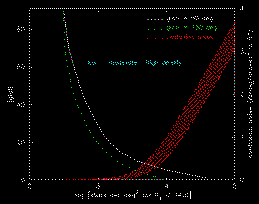iv. Photometry
Given the assorted shape, size and surface brightness that galaxies exhibit
in the near-infrared, a corresponding diverse array of apertures is used to
compute the integrated fluxes. Contamination from stars within or near the
aperture boundary is minimized with pixel masking-but still remains
significant when the confusion noise is high. Flux from masked pixels is
"recovered" with isophotal substitution, where the mean value of the elliptical
isophote (based on the elliptical shape parameters, b/a and
 ) replaces the given masked pixel that the
isophote passes through. More detailed discussion of stellar contamination and
rectification thereof in 2MASS galaxy photometry can be found in Jarrett et
al. (1996, in The Impact of Large Scale Near-IR Sky Surveys, p. 213).
) replaces the given masked pixel that the
isophote passes through. More detailed discussion of stellar contamination and
rectification thereof in 2MASS galaxy photometry can be found in Jarrett et
al. (1996, in The Impact of Large Scale Near-IR Sky Surveys, p. 213).
The simplest measures come from fixed circular apertures. Fluxes are
reported for a set of fixed circular apertures at the following radii: 5, 7,
10, 15, 20, 25, 30, 40, 50, 60, and 70´´,
centered on the J-band peak pixel. (Note: the large set of apertures was
chosen so that the user could generate a curve of growth to estimate the total
flux). We report both the integrated flux within the aperture (with fractional
pixel boundaries) and the estimated uncertainty in the integrated flux. The
magnitude uncertainty is based solely on the aperture size and the measured
noise in the Atlas image, which includes both the read-noise component and
background Poisson component, as well as the confusion noise component, which
becomes significant when the stellar source density is high (see
Appendix B).
The uncertainty does not incorporate other errors due to source
contamination, background gradients (e.g., airglow ridges with a higher spatial
frequency than the background removal process can handle; see
above),
zero-point calibration error, and uncertainties in the adaptive apertures
(e.g., isophotal photometry, see below). A more detailed discussion of the
2MASS galaxy photometry error tree can be found in Appendix A. Contamination,
confusion and masking flags are also attached to each flux. In the 2MASS
database the photometry names are, for example, "<band>_m_10",
"<band>_msig_10", and "<band>_flg_10", for the
10´´ radius aperture photometry, uncertainty and
confusion flag names, respectively.
For the great majority of faint galaxies in the 2MASS catalog, small fixed
circular apertures give the best compromise between increasing noise, due to
confusion and missing flux in the faint outer parts of galaxies. In particular,
the circular 7´´ radius aperture appears to have
the optimum match with the coupling between the 2MASS undersampling and PSF
elongation, with the H and Ks background noise, and with the size
of galaxies fainter than Ks~13 mag.
Adaptive aperture photometry includes isophotal and Kron metrics. The
isophotal measurements are set at the 20 mag per arcsec2 surface
brightness isophote at Ks and the 21 mag per arcsec2 at
J, using both circular and elliptically shape-fit apertures (see previous subsection). Kron aperture photometry (Kron 1980,
ApJS, 43, 305) employs a method in which the
aperture is controlled/adapted to the first image moment radius. The Kron
radius, which is frequently used in galaxy photometry as a "total" measure of
the integrated flux (Koo 1986, ApJ, 311, 651; Bertin & Arnouts 1996,
A&AS, 117, 393), turns out to
roughly correspond to the 20 mag per arcsec2 isophotal radius under
typical observing conditions. The minimum radius is set at
R=7´´, due to the rapidly increasing (PSF shape and
background noise) uncertainty in the isophotal or Kron radial measurement for
radii smaller than this limit.
For purposes of computing colors, two classes of adaptive photometry are
carried out: individual and fiducial. "Individual" photometry refers to
the use of adapted apertures derived per band, which is useful for single-band
limited studies. The 2MASS database names (semi-major axis radius, integrated
flux, uncertainty and confusion flag) for individual Kron photometry are
"<band>_r_e",
"<band>_m_e",
"<band>_msig_e", and
"<band>_flg_e", for elliptical apertures, and
"<band>_r_c",
"<band>_m_c",
"<band>_msig_c", and
"<band>_flg_c", for circular apertures.
Database names for individual 20 mag per arcsec2
isophotal photometry are
"<band>_r_i20e",
"<band>_m_i20e",
"<band>_msig_i20e", and
"<band>_flg_i20e", for elliptical apertures, and
"<band>_r_i20c",
"<band>_m_i20c",
"<band>_msig_i20c", and
"<band>_flg_i20c", for circular apertures.
Individual 21 mag per arcsec2 isophotal photometry names are
"<band>_r_i21e",
"<band>_m_i21e",
"<band>_msig_i21e", and
"<band>_flg_i21e", for elliptical apertures, and
"<band>_r_i21c",
"<band>_m_i21c",
"<band>_msig_i21c", and
"<band>_flg_i21c", for circular apertures.
The real power of 2MASS data is having simultaneous J-Ks, J-H
and H-Ks colors. Colors require a consistent aperture size
and shape for all three bands, based on either the J or Ks
isophotes, respectively referred to as the "J fiducial" and "K fiducial"
photometry. For the brighter galaxies in the catalog, Ks <
13 mag, the "K" fiducial isophotal elliptical aperture photometry
appears to give the most precise measurement (based on repeatability tests),
but errors in the ellipse fit to the 3 isophote
(see previous subsection) result in an uncertainty that
is difficult to evaluate (see Appendix A). The
adaptive circular apertures reduce some of that
uncertainty, but do increase the overall noise, due to additional sky noise
within the non-optimized aperture-resulting in a less precise, but more robust
measurement. 2MASS database names (semi-major axis radius, integrated flux,
uncertainty and confusion flag, respectively) for fiducial Kron photometry are
"r_fe",
"<band>_m_fe",
"<band>_msig_fe", and
"<band>_flg_fe", for elliptical apertures, and
"r_fc",
"<band>_m_fc",
"<band>_msig_fc", and
"<band>_flg_fc", for circular apertures.
Database names for fiducial 20 mag per arcsec2 isophotal photometry
are
"r_k20fe",
"<band>_m_k20fe",
"<band>_msig_k20fe", and
"<band>_flg_k20fe", for elliptical apertures, and
"r_k20fc",
"<band>_m_k20fc",
"<band>_msig_k20fc", and
"<band>_flg_k20fc", for circular apertures.
J-band fiducial 21 mag per arcsec2 isophotal photometry names are
"r_j21fe",
"<band>_m_j21fe",
"<band>_msig_j21fe", and
"<band>_flg_j21fe", for elliptical apertures, and
"r_j21fc",
"<band>_m_j21fc",
"<band>_msig_j21fc", and
"<band>_flg_j21fc", for circular apertures.
isophote
(see previous subsection) result in an uncertainty that
is difficult to evaluate (see Appendix A). The
adaptive circular apertures reduce some of that
uncertainty, but do increase the overall noise, due to additional sky noise
within the non-optimized aperture-resulting in a less precise, but more robust
measurement. 2MASS database names (semi-major axis radius, integrated flux,
uncertainty and confusion flag, respectively) for fiducial Kron photometry are
"r_fe",
"<band>_m_fe",
"<band>_msig_fe", and
"<band>_flg_fe", for elliptical apertures, and
"r_fc",
"<band>_m_fc",
"<band>_msig_fc", and
"<band>_flg_fc", for circular apertures.
Database names for fiducial 20 mag per arcsec2 isophotal photometry
are
"r_k20fe",
"<band>_m_k20fe",
"<band>_msig_k20fe", and
"<band>_flg_k20fe", for elliptical apertures, and
"r_k20fc",
"<band>_m_k20fc",
"<band>_msig_k20fc", and
"<band>_flg_k20fc", for circular apertures.
J-band fiducial 21 mag per arcsec2 isophotal photometry names are
"r_j21fe",
"<band>_m_j21fe",
"<band>_msig_j21fe", and
"<band>_flg_j21fe", for elliptical apertures, and
"r_j21fc",
"<band>_m_j21fc",
"<band>_msig_j21fc", and
"<band>_flg_j21fc", for circular apertures.
Additional flux measures include the central surface brightness (peak pixel
flux) and the "core" surface brightness (average flux over a 5´´
radius). Database names are
"<band>_peak" and
"<band>_5surf",
for the peak and core surface brightness respectively.
Finally, a "system" measurement is carried out in which no stellar masking is
performed, nor any masking of flux from neighboring galaxies. The "system"
flux indicates the total flux in and about a galaxy, so it will include the
total light in closely interacting systems. A set of contamination flags
supplement the system measurements: one indicating stellar contamination and
the other neighboring galaxy "contamination." Database names are
"<band>_m_sys",
"<band>_msig_sys" and
"sys_flg", for the integrated flux, uncertainty and confusion flag,
respectively.
The extrapolation mags represent the "total" flux of the object.
The (circularly-shaped) radial surface brightness profile
is first fit with a two-parameter exponential function, deriving the scale
length  and modifier
and modifier
 ,
according to Eq. IV.5.2 (below).
The profile extends down to the 20 mag arcsec-2
isophote (per band). The inner 10´´ radius is excluded from the fit
due to the proximal effects of the PSF (hence, f0 is set to
the isophotal value at 10´´ radius). The exponential is then
extrapolated from the Kron radius (R<band>c,
corresponding to 2.5 times the first moment radius),
down to four times the Kron radius, with a maximum of 80´´ in radius.
,
according to Eq. IV.5.2 (below).
The profile extends down to the 20 mag arcsec-2
isophote (per band). The inner 10´´ radius is excluded from the fit
due to the proximal effects of the PSF (hence, f0 is set to
the isophotal value at 10´´ radius). The exponential is then
extrapolated from the Kron radius (R<band>c,
corresponding to 2.5 times the first moment radius),
down to four times the Kron radius, with a maximum of 80´´ in radius.
 ) is
~1 mag brighter than the point source limits, or
14.7 (2.1 mJy), 13.9 (3.0 mJy), and 13.1 (4.1 mJy) mag at J, H, Ks,
respectively, with the precise threshold depending on the brightness profile
of the extended source. Given the ~2´´ angular
resolution of the image data and the detector sensitivity, 2MASS is well
suited for detecting most types of galaxies to cz < 10,000 km/s and high
luminosity giant galaxies beyond 30,000 km/s. In addition to galaxies, 2MASS
will also identify compact and diffuse Galactic objects. The 2MASS catalogs
are expected to detect over 100 million stars and greater than 1 million
galaxies.
) is
~1 mag brighter than the point source limits, or
14.7 (2.1 mJy), 13.9 (3.0 mJy), and 13.1 (4.1 mJy) mag at J, H, Ks,
respectively, with the precise threshold depending on the brightness profile
of the extended source. Given the ~2´´ angular
resolution of the image data and the detector sensitivity, 2MASS is well
suited for detecting most types of galaxies to cz < 10,000 km/s and high
luminosity giant galaxies beyond 30,000 km/s. In addition to galaxies, 2MASS
will also identify compact and diffuse Galactic objects. The 2MASS catalogs
are expected to detect over 100 million stars and greater than 1 million
galaxies.
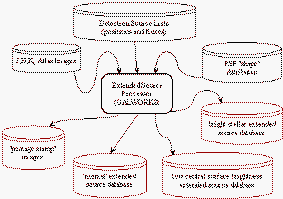
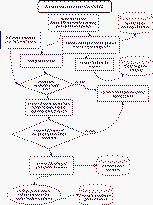
 r) taper. Here
r) taper. Here
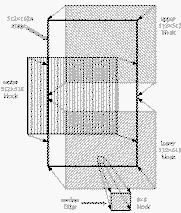
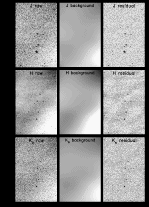
 ), are meant to
represent the object orientation. It is this orientation that is used
as a template for elliptical-isophotal and Kron photometry (described
), are meant to
represent the object orientation. It is this orientation that is used
as a template for elliptical-isophotal and Kron photometry (described


 and the population standard deviation is
and the population standard deviation is
 . If the ellipse
(oriented by b/a and
. If the ellipse
(oriented by b/a and  2 value. Therefore, by
minimizing the ratio of the standard deviation to the mean radius in
the distribution, we arrive at the best-fit ellipse solution. In this fashion,
the elliptical parameters are derived for each band. Due to the resolution and
sensitivity of the survey, there are practical limits to which we can measure
the orientation and size of a galaxy: the minimum axis ratio is floored at
0.10 and the minimum semi-major axis radius is 5.0´´ (see below).
We will refer to Eq. IV.5.1 as the "goodness of fit" or "chi-frac" metric; the
J and Ks-band database names are "j_chi_ellf" and
"k_chi_ellf", respectively. The goodness of fit
metric can used to indicate problems with the fit (due to stellar contamination
or noise in the case of faint sources) or real asymmetry in the object.
2 value. Therefore, by
minimizing the ratio of the standard deviation to the mean radius in
the distribution, we arrive at the best-fit ellipse solution. In this fashion,
the elliptical parameters are derived for each band. Due to the resolution and
sensitivity of the survey, there are practical limits to which we can measure
the orientation and size of a galaxy: the minimum axis ratio is floored at
0.10 and the minimum semi-major axis radius is 5.0´´ (see below).
We will refer to Eq. IV.5.1 as the "goodness of fit" or "chi-frac" metric; the
J and Ks-band database names are "j_chi_ellf" and
"k_chi_ellf", respectively. The goodness of fit
metric can used to indicate problems with the fit (due to stellar contamination
or noise in the case of faint sources) or real asymmetry in the object.
 and modifier
and modifier
 ,
according to Eq. IV.5.2 (below).
The profile extends down to the 20 mag arcsec-2
isophote (per band). The inner 10´´ radius is excluded from the fit
due to the proximal effects of the PSF (hence, f0 is set to
the isophotal value at 10´´ radius). The exponential is then
extrapolated from the Kron radius (R<band>c,
corresponding to 2.5 times the first moment radius),
down to four times the Kron radius, with a maximum of 80´´ in radius.
,
according to Eq. IV.5.2 (below).
The profile extends down to the 20 mag arcsec-2
isophote (per band). The inner 10´´ radius is excluded from the fit
due to the proximal effects of the PSF (hence, f0 is set to
the isophotal value at 10´´ radius). The exponential is then
extrapolated from the Kron radius (R<band>c,
corresponding to 2.5 times the first moment radius),
down to four times the Kron radius, with a maximum of 80´´ in radius.


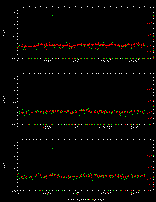
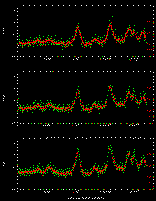
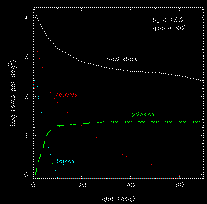
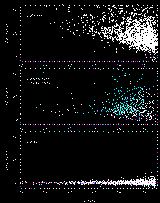
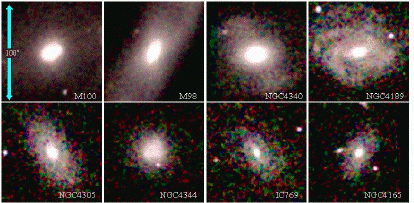

 3 stars in which the
alignment is symmetric across both the minor and major axes.
3 stars in which the
alignment is symmetric across both the minor and major axes.

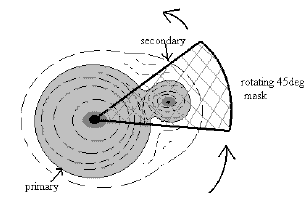
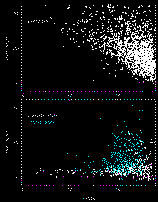
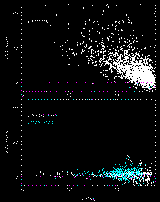


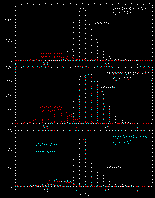
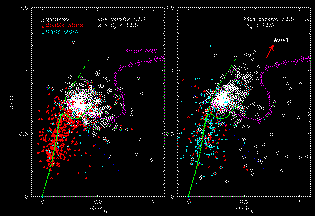
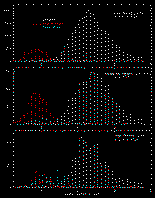

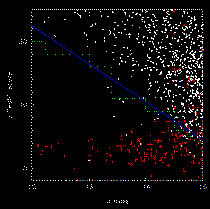



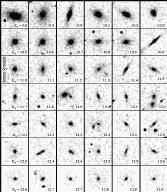
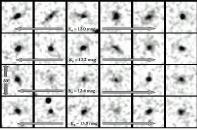
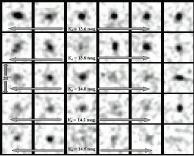
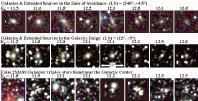
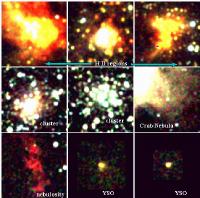
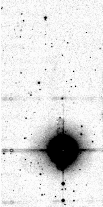

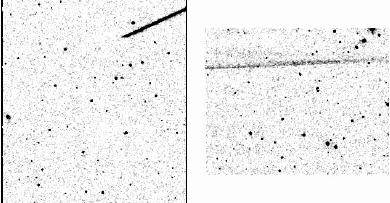



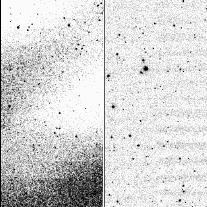


 , where
, where
 represents the effective
radius of the point spread function (typically ~2´´).
We may approximate the stellar flux distribution
with a power law of index
represents the effective
radius of the point spread function (typically ~2´´).
We may approximate the stellar flux distribution
with a power law of index 
 and
the differential stellar number density, is then
and
the differential stellar number density, is then

 ,
we may express the confusion noise
as a function of the stellar number density, N(flim), at the
limiting flux, flim, and the deflection cutoff, q,
,
we may express the confusion noise
as a function of the stellar number density, N(flim), at the
limiting flux, flim, and the deflection cutoff, q,

 = 13.6 arcsec2 (4´´ beam),
flim = 1.8 mJy (corresponding to Ks=14 mag), and
q between 3 and 5; the confusion noise has units of mJy.
= 13.6 arcsec2 (4´´ beam),
flim = 1.8 mJy (corresponding to Ks=14 mag), and
q between 3 and 5; the confusion noise has units of mJy.
 ,
raising the overall noise and
surface brightness of the background light. We desire to express the change in
the background surface brightness due to confusion noise as a function
of the stellar number density. We can turn the confusion noise into a surface
brightness by dividing by
,
raising the overall noise and
surface brightness of the background light. We desire to express the change in
the background surface brightness due to confusion noise as a function
of the stellar number density. We can turn the confusion noise into a surface
brightness by dividing by  to account for the noise limit after
averaging over a 4´´ diameter. Accordingly, we
arrive at a sky noise surface brightness of 21.6 mag/arcsec2,
representing the value at the north Galactic pole (NGP), which is negligibly
affected by confusion from stars. The confusion noise (in
to account for the noise limit after
averaging over a 4´´ diameter. Accordingly, we
arrive at a sky noise surface brightness of 21.6 mag/arcsec2,
representing the value at the north Galactic pole (NGP), which is negligibly
affected by confusion from stars. The confusion noise (in
